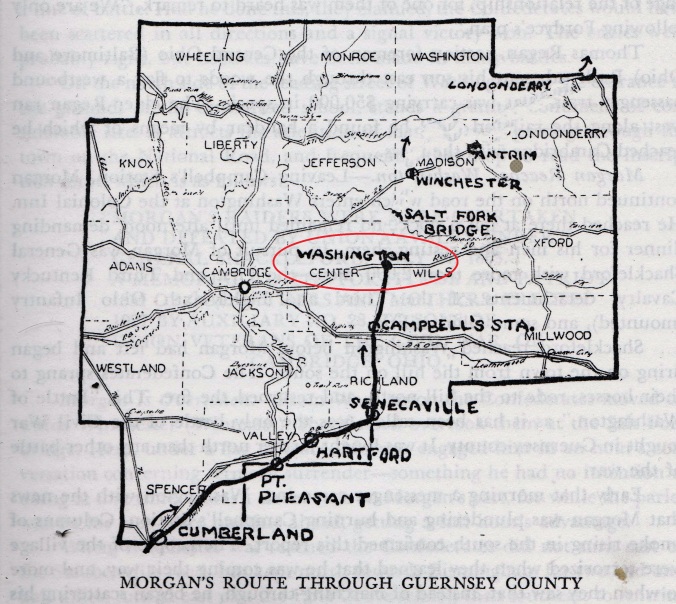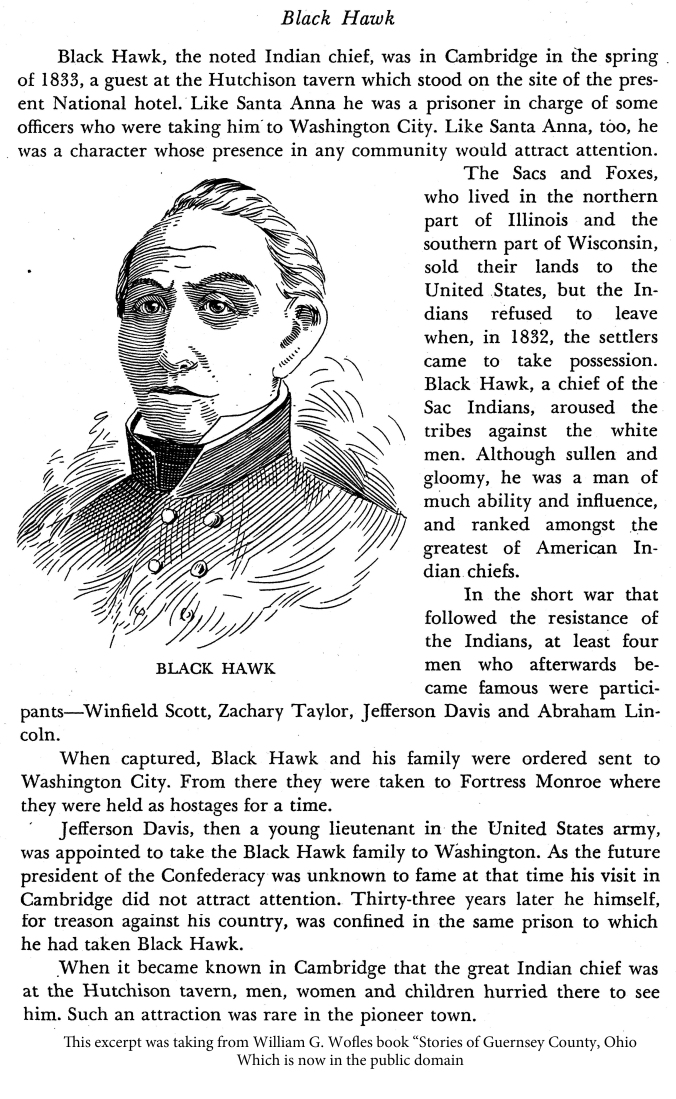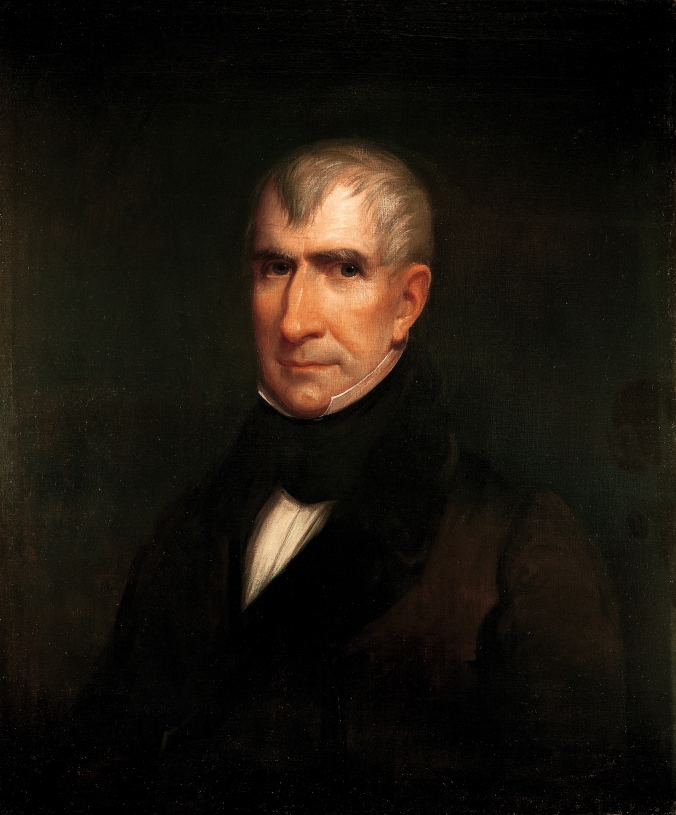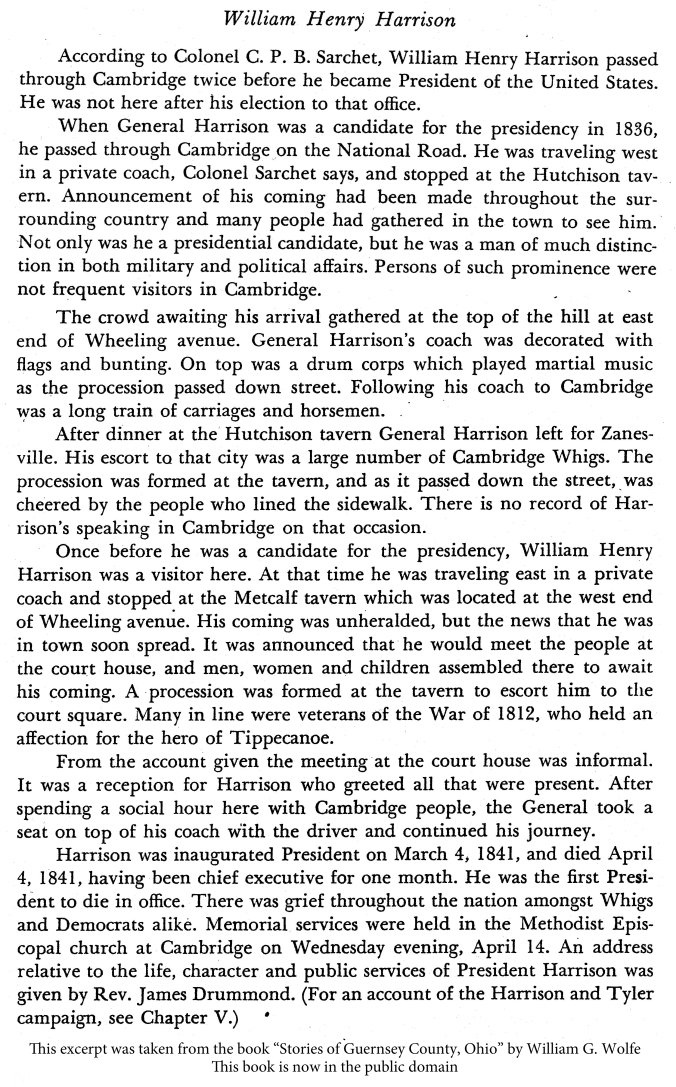
Make sure your rotation feature is on and flip your phone sideways to enjoy reading the page in a more pleasing format.
Introduction
Most citizens of Guernsey County are not aware of an epic event that happened right here during the Civil War. If this event had not happened at nearly the same time as the famous Battle of Gettysburg and the Battle of Vicksburg—both happened in July of 1863—certainly more of this story would be told to kids in history classes across the nation. However, the Battle of Gettysburg and Vicksburg are often placed on timelines and curriculums—rightfully—as the more important events to teach about when talking about the summer of 1863. Despite this, our ancestors here were certainly taught and aware of what’s known as “Morgan’s Raid.” According to William G. Wolfes book, Stories of Guernsey County, Ohio, which was published in 1943; older folks–during his lifetime–would still tell you when asked about their recollection of the Civil War, “I remember when Morgan went through.” Morgan’s Raid maybe considered by most historians as the most monumental thing to ever have happened in Guernsey County.
Summary
A Confederate General named John Hunt Morgan started a raid from Tennessee on June  11th, 1863 that ran through Kentucky, Indiana, and Ohio. The raid lasted until July 26th, covering 46 days total. After going through Kentucky Morgan decided to cross the Ohio River into Southern Indiana, and then go into Southern Ohio (both Union States), with 2,462 men under his command. When Mr. Morgan realized he had the attention of many Union officers, he tried to go back across the Ohio into West Virginia but by then the Union Troops had him blocked. Rather than wave the white flag and surrender, Mr. Morgan then decided to try and lose the Union Troops by continuing to head northeast. He hoped he could find a way back across the Ohio River somewhere. It was a “scorched earth” attack, as him and his soldiers plundered anything they came in contact with that would help them sustain themselves and burned anything they felt would help people attempting to stop them. They fought in a series of battles with Union supported militia’s and different Union regiments.
11th, 1863 that ran through Kentucky, Indiana, and Ohio. The raid lasted until July 26th, covering 46 days total. After going through Kentucky Morgan decided to cross the Ohio River into Southern Indiana, and then go into Southern Ohio (both Union States), with 2,462 men under his command. When Mr. Morgan realized he had the attention of many Union officers, he tried to go back across the Ohio into West Virginia but by then the Union Troops had him blocked. Rather than wave the white flag and surrender, Mr. Morgan then decided to try and lose the Union Troops by continuing to head northeast. He hoped he could find a way back across the Ohio River somewhere. It was a “scorched earth” attack, as him and his soldiers plundered anything they came in contact with that would help them sustain themselves and burned anything they felt would help people attempting to stop them. They fought in a series of battles with Union supported militia’s and different Union regiments.

“Panic in Louisville Kentucky
As he went through the different towns news traveled and gossip grew, Morgan and his men were taking necessary provisions from innocent citizens, but nothing nearly as viscous as the rumors conveyed. Morgan made it all the way through Guernsey County starting at its most southern town of Cumberland and leaving at one of our most northern towns Symra.
A short battle ensued in Old Washington, where some men were killed, others surrendered and were arrested, and some, including Morgan, got away and continued onward. The “Battle of Washington” as it would come to be known was the closest the Union got to making Morgan surrender or defeating him before he was overtaken two days later. Some critics say had General Shackleford of the Union, been less naive and more aggressive, Morgan could have been made to surrender here, as on his way through he was once overtaken near Salt Fork, but then got away again. None-the-less his raid and subsequent battle to get through Guernsey County are directly responsible for injuring and fatiguing his raiders enough to make them give up in Columbiana County, Ohio where they finally surrendered just two days after the Battle of Washington.
Morgan is Welcomed to Guernsey County with Open Arms
By Thursday July 23rd, the day Morgan entered Guernsey County, the raid had been going along for 42 days, almost a month and a half. Many of the Confederate Raiders were said to have looked tired and wore down. In the morning around 9:00 a.m. the Raiders were running from Colonel R.W. McFarland’s advance around the borders of Guernsey, Morgan, Noble and Muskingum County. In between Muskingum County where the town of Zeno used to reside, and where Cumberland sits today in Guernsey County, lived a Cumberland grocer and harness maker named Theodore Frazee. Here we have a story that shows just how close Confederate strangers were to Union strangers, where an American brotherhood saves a man from falling victim to a nation at war with itself.
At 10:00 a.m. in the morning Mr. Frazee is approached by Cumberland doctor John McCall. McCall was traveling from Zeno–now what we call a ghost town–on his way back to Cumberland when he stopped to warn Mr. Frazee of the raiders coming their way. He rode by horse screaming “Morgan’s Coming! Morgan’s Coming!” One can think of Paul Revere almost a century before famously doing a very similar thing. Mr. Frazee—hearing the doctor’s warning—frantically got to work hiding his most prized horses so the Raiders could not find them. He left only his eldest horse Old Barney in plain sight for them to see and he went back to his porch to await their arrival. With the doctor and the horse seemingly oblivious, Old Barney was taken by his daughter and wife to the sheep barn where the raiders could not find him. Frazee certainly heard the raiders coming as the sound of hundreds of horse hooves chattered from a distance kicking up dust on the old road. When the starving men seen the grocery they immediately began jumping from their horses to grab what they wanted in the name of the Confederate States of America. Suddenly Morgan shouted at them, “Halt! The first man who enters that house without orders will be shot! And pay for anything you take in the store. (Horwitz 2001.)”
The men were certainly confused. What had changed since the last time they had come about a grocery store and were allowed to sack the place? Well, when Mr. Morgan arrived he looked upon Mr. Frazee sitting on his porch with his hand held in a way that only a fellow brother of the ancient Society of Freemasonry would recognize. In this moment Morgan chose to have mercy on his fellow American brother rather than allow his men to make a victim of him. Likewise, Mr. Frazee showed his humanity by having his family cook the best lunch possible for Morgan and his men, more or less cleaning them out of their food supply. According to his daughter’s diary, the men made off with Daddies good horses, while Old Barney was spared from the ladies having taken him to the sheep barn. So it is somewhat safe to say, when John H. Morgan and his raiders came upon Guernsey County, they were welcomed with open arms and sent on their way with new horses.
According to David Thompson, who did his senior seminar on Morgan’s Raid, and is a graduate of History from Muskingum University, as well as a productive member of the Guernsey County Historical Society, the site would have been one to behold,
“He left Kentucky with 2,462 men and officers. By the time he got to Guernsey County only about 600 remained. The rest having been killed, wounded or captured. Three were killed in the skirmish at Old Washington. All were cavalrymen and would have all been on horseback. They travelled quickly and pretty much lived off the land with no support structure. For example, they rode diagonally across Guernsey County from SW to NE and were in and out of the county in little more than 24 hours. They constantly stole horses to keep fresh rides. I do remember one account that said Morgan sometimes road in a buggy (Thompson 2016.)”
Cumberland

Morgan Enters Guernsey County in Cumberland
When Morgan entered the town of Cumberland it was somewhere around 3:00 o’clock in the afternoon on the 23rd of July. They approached a house that was well-known in the community as a landmark, called the Globe Home; the house was owned by Dr. Stone. Here General Morgan set up headquarters for a short time. Some ransacked the house for any food and supplies they could find, while others fell asleep in the many rooms the doctor had to offer. When they went for Dr. Stones horses the doctor pleaded with them to leave his most prized one. He told them a white-lie, he said he had a very-ill patient he needed to see. Dr. Stone offered the men $75 (about $1,460 dollars today) to keep the horse. The cash was taken and the horse was left. However, later that evening, a set of the raiders that were lagging behind, came along and took the horse while they plundered nearly all the general stores of the town. This left the Doctor without any money and no horse to see his supposed dying patient. Imagine the fear and helplessness the doctor must have felt to see hundreds raiders run off into the night on his horses with all of his savings. Before Morgan left Cumberland he forced a local man to accompany him as a guide to the next town.
Point Pleasant, Hartford and Senecaville

From Cumberland the Raiders took a road northeast to Pt. Pleasant, a town known today as Pleasant City. When they arrived–now the evening of the day–they allowed their Cumberland guide to return home on his own horse. Again, Morgan’s overall goal was to eventually make it to the Ohio River near West Virginia where he must have thought he would have better success making it back to a southern state. In the meantime, he needed to feed and rest his tired and hungry men, so he kept a steady track headed northeast, choosing to pick up guides and drop them off once he had reached the next town at which he could use to revitalize his men. When he reached Point Pleasant, the owner and operator of the local Elks Hotel, Harrison Secrest, was picked up as his next guide. In route to Hartford (known today as Buffalo) and Senecaville, the Raiders come across a bridge. Knowing the local Union Army was in pursuit of them they attempted to tear down the bridge. Apparently feeling this to laborious a task they then chose to burn the bridge. Many of the raiders swam their horses across the creek. The Bridge was put out quickly by a group of local people following them. General Shackleford of the Union Army was getting closer to him with each passing hour.

Through the night a group of the raiders straggling behind the lead, stopped to search for fresh horses at a stable. While looking at a dark bay horse—a local family’s most cherished possession— they seen a man slumped over on a horse heading in their direction. After failing to respond to the Confederates calls, they shot the man off of the horse. Upon further inspection they found John Happs, a confederate soldier of their own. One man was ordered to get Happs medical treatment, he rode back to Point Pleasant looking for Dr. Teeter only to find the local doctor’s horse had been stolen (Horwitz 2001.) Teeter—a passionate Union man—was able to get there in time to dislodge the bullet before it killed the man, but Happs needed care his fellow rebels were not able to give and he died as a result. This an example of how deeply exhausted Morgan’s men were by the time they entered Guernsey County and of how the group were in constant search for horses with fresh legs. They continued their march through the night into the early morning through Buffalo and Senecaville, before reaching Campbell’s stations in Lore City on the morning of Friday July 24th, 1863.
Lore City

Lore City has a very interesting story in the event known as Morgan’s Raid. There was no Lore City as we know it today, only a train depot called Campbell’s Station with a small collection of houses and citizens who the majority of which were likely local coal miners. The station carried anything a small town of the 1860’s might need, including a telegraph. When Morgan and his men went through here they caused more damage than any other place in the county. They burned a bridge that crossed Leatherwood Creek, they also burned three freight cars filled with tobacco. Because his son and namesake was a Lieutenant in the Union Calvary whom was also a successful raider himself, having plundered many Confederate strongholds in Kentucky and Tennessee; the owner of the tobacco, S.W. Fordyce, seen his warehouse and home burnt to the ground. Morgan’s men were aware of Mr. Fordyce’s son and his exploits, as some remarked while lighting the house on fire,
“We are only following Fordyce’s plan (Horwitz 2001.)”
While at Campbell’s Station, Morgan cleverly had one of his telegraphers send a message east to Barnesville inquiring about the defense set up between Lore City and Barnesville. Morgan’s plan from here was to start heading east towards the Ohio River, however, Provost Marshal McCartney more than likely supposing the telegraph coming from Morgan, sent word back that the area had more than enough soldiers there to protect it. This forced Morgan to head further north rather than east. On his way out he destroyed anything useful to the men trailing him under General Shackleford, including the telegraph lines (Wolfe 1943.) Morgan and his men continued on that morning growing yet even more tired and restless. They were headed towards what is today known as Old Washington where they would encounter General Shackleford for the first time.
The Battle of Washington/Morgan Escapes

About two hours after leaving Campbell’s Station in shambles the men arrived in Washington, Ohio. When entering the town from the South they come across the American Hotel at roughly 10:00 a.m. Exhausted from non-stop traveling and pillaging, Morgan gave orders to post men on each road traveling into the small town. The men were to swap out as they took turns using the towns resources to rejuvenate; his men took rest while the local housewives prepared them meals. The women had no choice as most of their men had taken off to fight in the war. This was a tedious mistake by Morgan. General Shackleford and accompanying Union forces were trailing him quickly and not far behind. Around Noon, Morgan made orders to leave, just shortly after Shackleford and his men had reached town where some of Morgan’s men remained.
At an outpost of the town one of the Confederate soldiers fired a shot to warn his fellow rebels of Shackleford’s presence. Morgan immediately rushed down the stairs of the American Hotel and out into the street. Some rebels ran to their horses and took off on Winchester Road going north, others stayed in the confusion. Shacklefords men started firing at the men from a distant hillside from the south facing north. The Confederates thus returned fired as they rode off on their horse’s. This exchange of gunfire in Guernsey County become known as the “Battle of Washington.” This conflict was further north than any other battle in the Civil War. Three Confederate soldiers were killed, several wounded, and eight were captured and taken to Cambridge where they were housed in the Guernsey County Jail.

The Battle of (Old) Washington
Shackleford noted the pursuit and battle,
“With 500 men, on the morning of the 21st, we resumed the chase. Traveling day and night, we came up with the enemy on Friday Morning, the 24th, at Washington. Captain Ward, of the Third Kentucky Cavalry, with his own company and a detachment of the First Kentucky, under Adjutant Carpenter, had command of the advance. He drove in the rebel pickets, and, by a flank movement, drove the entire rebel force out of the town of Washington, killing and wounding several of the enemy. One mile east (north) of Washington the enemy made a stand, in a dense wood. We formed a line of battle, and soon drove him from his position. He fell back 2 miles, tore up a bridge over a rugged stream (Salt Fork), and took up his left flank, while a portion of the Fourteenth Illinois crossed the stream just above the bridge, and moved up the hill in the face of a heavy fire from the enemy, steadily they moved up and drove him before them. Late Friday evening he burned two bridges over Stillwater, causing considerable delay. We succeeded in crossing and pressed on all night (Jr 1998.)”
16 year old Elizabeth McCullin also documented the event with the most vivid of eyewitness accounts (Perkowski 2011,)
“We were all frightened … The townspeople hid their horses and buried their valuables, The town was almost defenseless, since most of their men had joined the Union and gone off to war. Capt. John Laughlin, who lives south of town, was home on furlough and advised the residents to offer no resistance. Nearly all the town gathered at the corner where the Campbell’s Station-Winchester Road crossed the pike.
“Riding two abreast, the rebels came up the road. Rev. Ferguson, our Presbyterian minister, stepped out in front and waved a white handkerchief. The rebels did not pass through as we had hoped, but dismounted and gathered along the street. They entered homes and ordered dinners to be prepared for them immediately. Morgan and his staff of 14 men went to the American Hotel, rebel guards were placed around the town … Anyone could come in, but nobody was permitted to go out.
“Morgan and his staff ordered dinner at the hotel and the Smiths called in some of us older girls to help prepare the meal. I waited on the table … His soldiers having eaten their dinner and fed their horses, were lying on the street from one end of town to the other … Suddenly a gun was fired by one of the rebel guards as a signal that Gen. Shackelford was near. The soldiers ran to the horses and headed toward the Winchester road (now Morgan’s Way). There were in (Old) Washington for two or three hours.
“We saw Shackelford’s army gathering on Cemetery Hill. They began firing at the Confederates, who, in turn, shot back. Above the noise of the battle we could hear voices from the Federal lines ordering women and children to run to cellars. I ran to one that was nearest, where 20 or 30 other persons had gathered. The shooting continued. The Union men were firing from the south, the Confederates from the north. We could hear the bullets whizzing over our heads, and the crash of broken glass. It was terrible.
To think we had living and breathing rebels that fought in a battle housed in Guernsey County and eight of them taken to Cambridge—our county seat—to face justice. When the men were interviewed by local law and Union officials: they gave up Morgan’s plan to cross back over to the Ohio River, they expressed how severely exhausted they had become with the raid, and they spoke of their strong inclination to return home. Morgan got away and Shackleford faced heavy criticism for his decision to fire at long distance rather than charge to the town. Many said if he had taken command and charged the town, Morgan would not have escaped and the raid would have come to an end right here in Guernsey County.
Morgan Gets Away. Again

Morgan and the remainder of his men kept fleeing north towards Winterset. Shackleford caught up with him and overtook him at the Salt Fork Bridge. Morgan agreed to surrender but had no intention of actually doing it. Under the guise of a truce, Morgan had a conversation with Shackleford, all the while it was happening Morgan’s men were fleeing further north. At some point Shackleford turned his attention away from Morgan allowing him to flee as well. Again, Shackleford would be criticized for letting Morgan slip through his fingers, though, as people would find out later, he was not alone in having this happen. Shackleford gave critics reason to believe he was much more vanilla than the man he was charged with capturing. John Hunt Morgan gave critics reason to believe he could not be captured by anyone. The men left Guernsey County at the town of Symra near Londonberry. He entered Guernsey County at its most south eastern point and left Guernsey county at its most north eastern point, totaling a period of 24 hours.

Then Proves an Exceptional Escape Artist
Two days after fooling Shackleford and leaving Guernsey County with more than $40,000 in destruction, ($780,000 in today’s money according to measuringworth.com 2016.) Shackleford’s forces caught up with Morgan once more and finally got him to surrender where Salineville is today in Columbia County Ohio (Jeffersonian 1863.) He had just 335 of his men remaining from the 2,462 from which he started the raid (Jr 1998.) When captured these men were sent to several different prisons across the state. Morgan himself was sent to the state capital where he proved to be one of the greatest escape artist of the Civil War. In Columbus, he and six of his captains managed to climb the wall of the Ohio Penitentiary. Once out and free Morgan managed to gain plain clothes that allowed him to walk right into the Union Terminal in Cincinnati unnoticed. According to Morgan he had an interesting discussion with a Union Officer while in disguise after boarding the train. The Union Officer said to him as they passed a penitentiary,
“Over there is where Morgan is now spending his leisure time.” Morgan responded, “and he ought to be kept there until the end of the war (Wolfe 1943.)

Bibliography
Horwitz, Lester V. 2001. The Longest Raid of the Civil War: Little-Known & Untold Stories of Morgan’s Raid Into Kentucky, Indiana & Ohio. Cincinnati: Farmcourt Publishing.
Jeffersonian, The Daily. 1863. “Property Taken, Destroyed in County As Result of Raid Valued at $40.074.” July 30.
Jr, Russell H. Booth. 1998. A Brief History of Guernsey County, Ohio: Including the Morgan Raid Claims. Cambridge, Ohio: Gomber House Press.
measuringworth.com. 2016. measuringworth.com. July 16. Accessed July 16, 2016. https://www.measuringworth.com.
Perkowski, Judie. 2011. “The Daily Jeffersonian.” The Daily Jeffersonian. August 21. Accessed July 23, 2016. http://www.daily-jeff.com/community/2011/08/21/civil-war-arrives-in-guernsey-county-with-morgan-s-raid.
Thompson, David, interview by James Shively. 2016. How Morgan entered Guernsey County? (July).
Wolfe, William G. 1943. Stories of Guernsey County, Ohio. Kingsport Tennessee: Kingsport Press.






